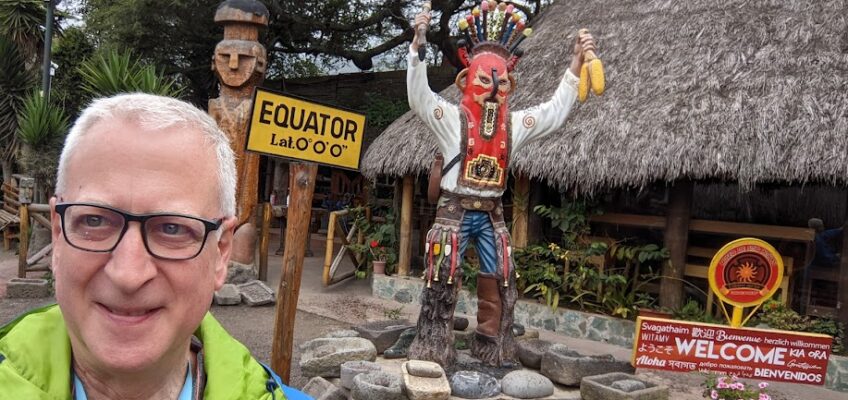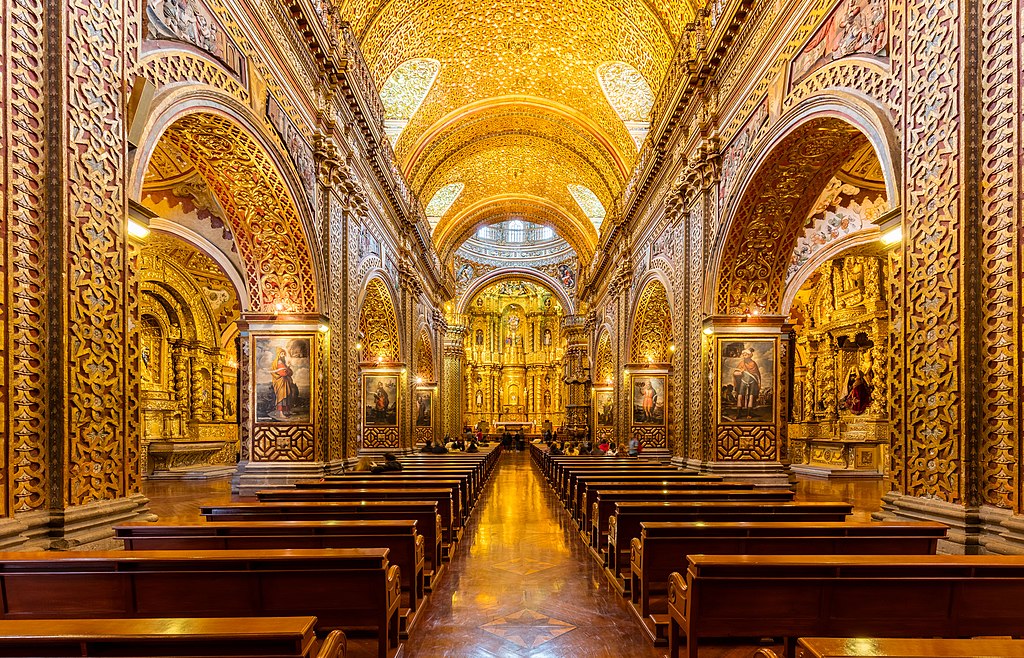Arrival
We arrived at Mariscal Sucre Quito International Airport, which opened in 2013, and after we got through immigration and customs, we met Celso, our tour leader for Ecuador, and David, who is training to be a tour leader for OAT.
By the time we got to our hotel, it was nearly 8:00 pm. A long day! But we went across the street to a Tex-Mex sports-themed restaurant before crashing.
Gothic
The last thing I expected to see in Quito was a Gothic church. (Well maybe not the last thing. Maybe an elephant or a kangaroo would be the last thing. Unless I went to the zoo.)
The Basílica del Voto Nacional (Basilica of the Sacred Vow) is actually neo-Gothic. Construction took place between 1892 and 1909, and it was consecrated in 1988.
If you look closely, you’ll see some distinctly Ecuadorian features.
Chocolate
Chocolate (and vanilla) originated in Mexico. If I go home and suggest that this is not true, they might arrest me for sedition.
But at the chocolate factory we visited in Cusco, and again here in Quito, we have learned that chocolate originated in South America. And here is corroboration:
Botanical evidence shows the plant from which chocolate is made was first grown for food more than 5,000 years ago in the Amazon rainforest.
Chemical residues found on ancient pottery suggest cocoa was used as a food, drink or medicine by indigenous people living in what is now Ecuador.
Until now it was thought that chocolate originated much later and in Central rather than South America.
Researchers analysed pottery vessels from the Santa Ana (La Florida) archaeological site in the highlands of Ecuador, which was occupied between 5,300 and 2,100 years ago.
A number of crops have been documented there, including corn, sweet potatoes and the cacao tree Theobroma cacao.
Traces of chemicals and DNA from the plant were found on pottery, suggesting the ground seeds of the cocoa pod were being mixed into a concoction and drunk.
Conexión Chocolate
We stopped at the Laboratorio del Chocolate, an outlet of República del Cacao, where we got to taste and, of course, buy some chocolate.
They sold ice cream too!
My love for chocolate has reached new heights on this trip.
Churches and other beautiful buildings
Quito has many churches and attractive colonial architecture.
When we got to this church, Celso had us line up single file, put our hands on the shoulders of the person in front of us, and close our eyes. Then we walked slowly into the church. When he told us to open our eyes, here’s what we saw:
Prostitution in Quito
Celso introduced us to Cristina, a sex worker in Quito. She is 39 years old and has a 20-year-old son and a 15-year-old daughter. She grew up in Colombia in an abusive family situation. At the age of 19 she met a man, fell in love, and moved with him to Quito. He then forced her into prostitution. He became violent, and she finally left. She continues to work as a prostitute because she needs the money in order to give her children a better life than the one she had.
Prostitution is legal in Ecuador and is regulated by the government. Cristina must be tested for HIV and other STDs every two weeks. She belongs to a union. Of the $13 she charges for ten minutes, she keeps $10; the remaining $3 goes to the union.
Cristina broke down in tears several times as she told us her story. I was deeply moved, as were most of our group. The situation is complicated and definitely more nuanced than I thought before we had our conversation with Cristina.
On the one hand, people should have the right to earn a living, as long as no one is harmed. On the other hand, prostitution brings with it a myriad of other problems. Perhaps if it weren’t legal, Cristina’s partner wouldn’t have been able to take her to Ecuador and force her into this life.
I don’t think there are easy answers, but I do think our talk with Cristina provided a lot of food for thought.
Javier
After we finished our conversation with Cristina, Celso introduced us to Javier. Javier used to be a pickpocket on the streets of Quito. Eventually he was arrested, tried, convicted, and sent to prison. A month into his term, he learned that his girlfriend was pregnant.
After he was released, he decided to straighten up his act, and he became an artist. He is a member of the Tigua, a collection of small communitites southwest of Quito. The Tigua are renowned for their colorful folk art, painted with chicken-feather brushes on sheepskin canvases. When Javier pulled out some of his work from his backpack, I was impressed. I’m not generally a fan of primitivism, but I love Javier’s story and bought the painting in the photo.
Day Two in Quito, fast and furious
I’m jumping ahead, and I’ll just provide some highlights. It’s already Friday night as I’m writing, and I’m in my hotel room in Puerto Ayora, at the south end of Isla Santa Cruz in the Galápagos. I meant to finish this last night before we left Quito, but circumstances refused to cooperate. And if I don’t finish now, I won’t get to finish until after I get home, because starting tomorrow I’ll have no more internet access.
We started the day yesterday at Mercado La Carolina. Similar to the market we visited in Urubamba in Peru’s Sacred Valley, this market consists of various stalls where you can buy meat, poultry, eggs, seafood, fruits, vegetables, flowers, and various other products.
Celso gave us each a dollar and tasked us each with buying something he wouldn’t be able to identify.
Our next stop was the Equator. It was pretty cool to be right on the Equator.
Then we went to a wonderful museum that ranks with my favorite non-art museums: El Museo de Artesanías del Ecuador “Mindalae.” This museum displays various handcrafts from indigenous groups of the coastal region, the Andes, and the Amazon. We got a tour and they also served us a really nice lunch.
Afterwards I was going to get this blog post done, but I ended up going out for dinner with Celso and a few other members of the group. It was great, but it took way longer than I anticipated. And we had to get up at 4am today to begin our travels to the Galápagos.
Bye til later
So this is the last you are likely to hear from me until I get home. Tomorrow we board the boat where we will spend the next three nights. No internet, no phone, no connection to the outside world.
And no more photos of food posted to Facebook.



Tamera
OMG! That church!
Lane
It was truly something! Thanks for reading, Tamera!